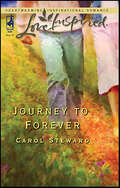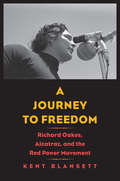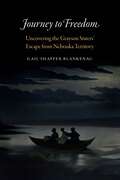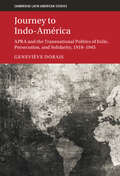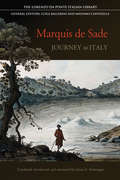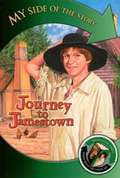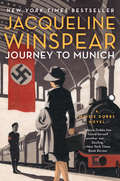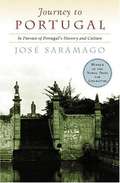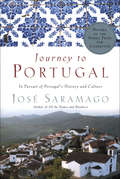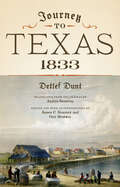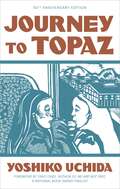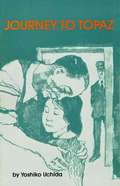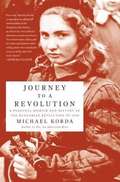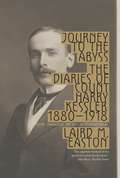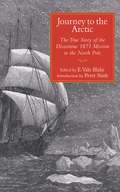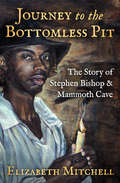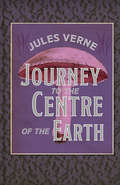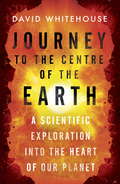- Table View
- List View
Journey to Forever
by Carol StewardEight Days and 300 MilesThat was how long privileged fledgling journalist Nikki Post had to deal with notorious radio personality Colin Wright and the staff on his eight-day fund-raising trek from New Mexico to Wyoming.Yet instead of the immature prankster she'd been warned to expect, Colin was generous and handsome-with a smile that reached the depths of Nikki's soul. As the days counted down, he helped her write the article for her grandfather's newspaper-and a kiss shortened the distance between them.But when trouble threatened to bring the trip to a premature end, would Nikki's role in Colin's life end, as well...or continue forever?
Journey to Freedom: Richard Oakes, Alcatraz, and the Red Power Movement (The Henry Roe Cloud Series on American Indians and Modernity)
by Kent BlansettThe first book-length biography of Richard Oakes, a Red Power activist of the 1960s who was a leader in the Alcatraz takeover and the Red Power Indigenous rights movement A revealing portrait of Richard Oakes, the brilliant, charismatic Native American leader who was instrumental in the takeovers of Alcatraz, Fort Lawton, and Pit River and whose assassination in 1972 galvanized the Trail of Broken Treaties march on Washington, DC. The life of this pivotal Akwesasne Mohawk activist is explored in an important new biography based on extensive archival research and key interviews with activists and family members. Historian Kent Blansett offers a transformative and new perspective on the Red Power movement of the turbulent 1960s and the dynamic figure who helped to organize and champion it, telling the full story of Oakes’s life, his fight for Native American self-determination, and his tragic, untimely death. This invaluable history chronicles the mid-twentieth century rise of Intertribalism, Indian Cities, and a national political awakening that continues to shape Indigenous politics and activism to this day. TEST
Journey to Freedom: Uncovering the Grayson Sisters' Escape from Nebraska Territory
by Gail Shaffer BlankenauIn late November of 1858 two enslaved Black women—Celia Grayson, age twenty-two, and Eliza Grayson, age twenty—escaped the Stephen F. Nuckolls household in southeastern Nebraska. John Williamson, a man of African American and Cherokee descent from Iowa, guided them through the dark to the Missouri River, where they boarded a skiff and crossed the icy waters, heading for their first stop on the Underground Railroad at Civil Bend, Iowa. In Journey to Freedom Gail Shaffer Blankenau provides the first detailed history of Black enslavement in Nebraska Territory and the escape of these two enslaved Black women from Nebraska City. Poised on the &“frontier,&” the Graysons&’ escape demonstrated that unique opportunities beckoned at the confluence of Nebraska, Missouri, Iowa, and Kansas, and their actions challenged slavery&’s tentative expansion into the West and its eventual demise in an era of territorial fluidity. Their escape and the violence that followed prompted considerable debate across the country and led to the Nebraska legislature&’s move to prohibit slavery. Drawing on multiple collections, records, and slave narratives, Journey to Freedom sheds light on the Graysons&’ courage and agency as they became high-profile figures in the national debate between proslavery and antislavery factions in the antebellum period.
Journey to Independence: Blindness, The Canadian Story
by Euclid HerieThis book covers the history of the blind in Canada from the 19th century to the present. It's focus is on the leaders of the blind community that eventually led to the founding of the Canadian National Institute for the Blind, (CNIB). It's author, Euclid Heri, is a blind man and a leader in the world blind union as well as in Canada. He was the president of both the CNIB and the World Blind Union.
Journey to Indo-América: APRA and the Transnational Politics of Exile, Persecution, and Solidarity, 1918–1945 (Cambridge Latin American Studies #123)
by Geneviève DoraisThe American Popular Revolutionary Alliance (APRA) was a Peruvian political party that played an important role in the development of the Latin American left during the first half of the 1900s. In Journey to Indo-América, GenevieÌve Dorais examines how and why the anti-imperialist project of APRA took root outside of Peru as well as how APRA's struggle for political survival in Peru shaped its transnational consciousness. Dorais convincingly argues that APRA's history can only be understood properly within this transnational framework, and through the collective efforts of transnational organization rather than through an exclusive emphasis on political figures like APRA leader, Víctor Raúl Haya de la Torre. Tracing circuits of exile and solidarity through Latin America, the United States, and Europe, Dorais seeks to deepen our appreciation of APRA's ideological production through an exploration of the political context in which its project of hemispheric unity emerged.
Journey to Italy (Lorenzo Da Ponte Italian Library)
by Marquis de SadeIn 1775, the young Count de Sade decided to turn a flight from legal trouble into an opportunity to undertake the "grand tour." He transformed his sojourns in Florence, Rome, Naples, and their environs into a philosophical travelogue; alongside advice on where to go and what to see, his Journey to Italy would include analyses of local customs and institutions, history and politics, natural phenomena, and the development of the arts. For today’s readers, Journey to Italy provides remarkable portraits of major Italian cities and the surrounding countryside, vivid accounts of aristocratic and popular entertainments, and a clear sense of what it was like to be a tourist in eighteenth-century Italy – from scams, rough roads, and unreliable guidebooks to learned interlocutors, balls, and nights at the opera. We witness Sade learning about the lives of Roman emperors, the machinations and misdeeds of pontiffs, the power struggles of the Medici, the ancient libertine world revealed by the excavations of Herculaneum and Pompeii, and a host of artistic examples and cultural practices – the material he would soon metamorphose into trenchant satire, gothic horror, and violent sexual fantasy. This book presents the first English translation of Sade’s unfinished and unpolished Journey to Italy along with his extensive dossiers of notations, sketches, plans, and correspondence. The translation is accompanied by extensive explanatory annotations and preceded by a critical introduction that provides biographical, artistic, historical, and intellectual context for Sade’s fascinating project, connecting his travels in and writings about Italy to his later famous and controversial works.
Journey to Jamestown: Elias's Story and Sacahocan's Story (My Side of the Story)
by Lois RubyElias sets sail for a new life in the Jamestown Colony where he discovers that he has a knack for healing. He meets Sacahocan, a Pamunkee Indian girl who is training to be a medicine woman and dream reader. Though their leaders are at war, Elias and Sacahocan forge a friendship by sharing their medical knowledge.
Journey to Kansas (Leveled Readers 5.5.2)
by Delores Lowe FriedmanA story about a journey from Kansas west as part of a wagon train.
Journey to Munich: A Maisie Dobbs Novel (Maisie Dobbs #12)
by Jacqueline Winspear<P>Working with the British Secret Service on an undercover mission, Maisie Dobbs is sent to Hitler's Germany in this thrilling tale of danger and intrigue--the twelfth novel in Jacqueline Winspear's New York Times bestselling "series that seems to get better with each entry" (Wall Street Journal). <P>It's early 1938, and Maisie Dobbs is back in England. On a fine yet chilly morning, as she walks towards Fitzroy Square--a place of many memories--she is intercepted by Brian Huntley and Robert MacFarlane of the Secret Service. The German government has agreed to release a British subject from prison, but only if he is handed over to a family member. Because the man's wife is bedridden and his daughter has been killed in an accident, the Secret Service wants Maisie--who bears a striking resemblance to the daughter--to retrieve the man from Dachau, on the outskirts of Munich. <P>The British government is not alone in its interest in Maisie's travel plans. Her nemesis--the man she holds responsible for her husband's death--has learned of her journey, and is also desperate for her help. <P>Traveling into the heart of Nazi Germany, Maisie encounters unexpected dangers--and finds herself questioning whether it's time to return to the work she loved. But the Secret Service may have other ideas. . . . <P><b>A New York Times Bestseller</b>
Journey to Nashvill: A Story of the Founding
by Alfred Leland CrabbAlfred Leland Crabb is a historian who is thorough in his research even while writing a good historical novel, and Journey To Nashville is such a book. James Robertson and John Donelson were two wise and intrepid men who wer compelled by the westward moving spirit to lead Robertson a land journey, and Donelson a flatboat voyage to the place which would one day become a kind of "promised land." These journeys were frought with trials, tribulations, but ultimately with adventure which characterized the spirit and courage of the pioneers of that day and time. His portrayal of Historical fiction is such an interesting way to learn some aspects of history. This book is a well done story of the long trip taking the families downriver & upriver and through an untamed wilderness to get to the destination that would one day become Nashville, Tennessee.
Journey to Portugal: In Pursuit of Portugal's History and Culture
by José Saramago Nick Caistor Amanda HopkinsonWhen José Saramago decided some twenty years ago to write a book about Portugal, his only desire was that it be unlike all other books on the subject, and in this he has certainly succeeded. Recording the events and observations of a journey across the length and breadth of the country he loves dearly, Saramago brings Portugal to life as only a writer of his brilliance can. Forfeiting sources of information such as tourist guides and road maps, he scours the country with the eyes and ears of an observer fascinated by the ancient myths and history of his people. Whether an inaccessible medieval fortress set on a cliff, a wayside chapel thick with cobwebs, or a grand mansion in the city, the extraordinary places of this land come alive with kings, warriors, painters, explorers, writers, saints, and sinners. Always meticulously attentive to those elements of ancient Portugal that persist today, Saramago examines the country in its current period of rapid transition and growth. Infused with the tenderness and intelligence that have become familiar to his readers, Saramago's Journey to Portugal is an ode of love for a country and its rich traditions.
Journey to Portugal: In Pursuit of Portugal's History and Culture
by José SaramagoThe Nobel Prize–winning author explores his homeland in &“this monumental work, a literary hybrid&” of cultural history, literary nonfiction, and travelogue (Publishers Weekly). In 1979, José Saramago decided to write a book called Journey to Portugal—and dedicated himself to obtaining the fullest meaning of his title. More than merely journeying in or through his native country, he wanted to achieve a deep encounter with it, foregoing the conventional assumptions and the routines of tourist guides. Instead, he scoured the country with the eyes and ears of an observer fascinated by the ancient myths and history of his people. Recording his experiences and observations across the length and breadth of Portugal, Saramago brings the country to life as only a writer of his brilliance can. Whether an inaccessible medieval fortress set on a cliff, a wayside chapel thick with cobwebs, or a grand mansion in the city, the extraordinary places of this land come alive with kings, warriors, painters, explorers, writers, saints, and sinners. Infused with the tenderness and intelligence that have become familiar to his readers, Saramago's Journey to Portugal is an ode of love for a country and its rich traditions.
Journey to Texas, 1833
by Detlef DuntIn 1834, a German immigrant to Texas, D. T. F. (Detlef Thomas Friedrich) Jordt, aka Detlef Dunt, published Reise nach Texas, a delightful little book that praised Texas as “a land which puts riches in [the immigrant’s] lap, which can bring happiness to thousands and to their descendants.” Dunt’s volume was the first one written by an on-the-ground observer to encourage German immigration to Texas, and it provides an unparalleled portrait of Austin’s Colony from the lower Brazos region and San Felipe to the Industry and Frelsburg areas, where Dunt resided with Friedrich Ernst and his family. Journey to Texas, 1833 offers the first English translation of Reise nach Texas. It brings to vivid life the personalities, scenic landscapes, and customs that Dunt encountered in colonial Texas on the eve of revolution, along with his many practical suggestions for Germans who intended to emigrate. The editors’ introduction describes the social, political, and economic conditions that prompted Europeans to emigrate to Texas and provides biographical background on Dunt and his connection with Friedrich Ernst. Also included in the volume are a bibliography of German works about Texas and an interpretive essay discussing all of the early German literature about Texas and Dunt’s place within it. Expanding our knowledge of German immigration to Texas beyond the more fully documented Hill Country communities, Journey to Texas, 1833 also adds an important chapter to the story of pre-Revolutionary Texas by a sophisticated commentator.
Journey to Texas, 1833
by Detlef DuntIn 1834, a German immigrant to Texas, D. T. F. (Detlef Thomas Friedrich) Jordt, aka Detlef Dunt, published Reise nach Texas, a delightful little book that praised Texas as “a land which puts riches in [the immigrant’s] lap, which can bring happiness to thousands and to their descendants.” Dunt’s volume was the first one written by an on-the-ground observer to encourage German immigration to Texas, and it provides an unparalleled portrait of Austin’s Colony from the lower Brazos region and San Felipe to the Industry and Frelsburg areas, where Dunt resided with Friedrich Ernst and his family. Journey to Texas, 1833 offers the first English translation of Reise nach Texas. It brings to vivid life the personalities, scenic landscapes, and customs that Dunt encountered in colonial Texas on the eve of revolution, along with his many practical suggestions for Germans who intended to emigrate. The editors’ introduction describes the social, political, and economic conditions that prompted Europeans to emigrate to Texas and provides biographical background on Dunt and his connection with Friedrich Ernst. Also included in the volume are a bibliography of German works about Texas and an interpretive essay discussing all of the early German literature about Texas and Dunt’s place within it. Expanding our knowledge of German immigration to Texas beyond the more fully documented Hill Country communities, Journey to Texas, 1833 also adds an important chapter to the story of pre-Revolutionary Texas by a sophisticated commentator.
Journey to Topaz (50th Anniversary Edition)
by Yoshiko UchidaCelebrating the 50th anniversary of a landmark work of juvenile fiction This much-loved and widely read classic is the moving story of one girl’s struggle to remain brave during the World War II incarceration of Japanese Americans. In 1941, eleven-year-old Yuki is looking forward to Christmas when disaster strikes: she and her family, along with everyone of Japanese descent on the West Coast, are labeled enemy aliens. The FBI arrests her father, and she, her mother, and her brother are imprisoned in a bleak and dusty camp surrounded by barbed wire in the Utah desert. There, she and her family experience both true friendship and heart-wrenching tragedy. Journey to Topaz explores the consequences of prejudice and the capacities of the human spirit. First published in 1971, this novel was the first children’s book about the wartime incarceration written by a Japanese American. This fiftieth anniversary edition features new cover art, a refreshed design, and a new foreword by Traci Chee.
Journey to Topaz: A Story of Japanese-American Evacuation
by Yoshiko UchidaAfter the bombing of Pearl Harbor, 11-year-old Yuki Sakane's family is uprooted and shipped with thousands of other West Coast Japanese-Americans to the horse stalls of Tanforan Racetrack and then to a bleak desert concentration camp called Topaz.
Journey to Yesterday
by June Lund ShiplettA TWENTIETH-CENTURY WOMAN ON A NINETEENTH-CENTURY ODYSSEY OF PASSION AND DANGER! The men at the party couldn't take their eyes off Stacey as the stunning redhead jackknifed into the swimming pool. But suddenly, mysteriously, she was gone, torn from her husband and daughters in Cleveland and thrust into the untamed pioneer days of America's past. Frightened and bewildered at first, Stacey felt safer when she became governess to handsome Ben Clayton's two motherless children. When he proposed to make the perilous journey out West by covered wagon, she agreed to go. But Stacey didn't know the depth of her desire for Ben, nor the savage excitement that awaited her. Would she ever return to her safe and comfortable life in the twentieth century? Or did her destiny now lie in the past with a love as strong and powerful as the one she left behind?
Journey to a Revolution
by Michael KordaThe Hungarian Revolution of 1956 was perhaps the most dramatic single event of the Cold War and a major turning point in history. Though it ended unsuccessfully, the spontaneous uprising of Hungarians against their country's Communist party and the Soviet occupation forces in the wake of Stalin's death demonstrated to the world at large the failure of Communism. In full view of the Western media--and therefore the world--the Russians were obliged to use force on a vast scale to subdue armed students, factory workers, and intellectuals in the streets of a major European capital.In October 1956, Michael Korda and three fellow Oxford undergraduates traveled to Budapest in a beat-up Volkswagen to bring badly needed medicine to the hospitals--and to participate, at street level, in one of the great battles of the postwar era. Journey to a Revolution is at once history and a compelling memoir--the author's riveting account of the course of the revolution, from its heroic beginnings to the sad martyrdom of its end.end.
Journey to a Revolution: A Personal Memoir and the History of the Hungarian Revolution of 1956
by Michael KordaThe Hungarian Revolution of 1956 was perhaps the most dramatic single event of the Cold War and a major turning point in history. Though it ended unsuccessfully, the spontaneous uprising of Hungarians against their country's Communist party and the Soviet occupation forces in the wake of Stalin's death demonstrated to the world at large the failure of Communism. In full view of the Western media--and therefore the world--the Russians were obliged to use force on a vast scale to subdue armed students, factory workers, and intellectuals in the streets of a major European capital. In October 1956, Michael Korda and three fellow Oxford undergraduates traveled to Budapest in a beat-up Volkswagen to bring badly needed medicine to the hospitals--and to participate, at street level, in one of the great battles of the postwar era. Journey to a Revolution is at once history and a compelling memoir--the author's riveting account of the course of the revolution, from its heroic beginnings to the sad martyrdom of its end.
Journey to the Abyss: The Diaries of Count Harry Kessler, 1880-1918
by Harry Kessler Laird EastonThese fascinating, never-before-published early diaries of Count Harry Kessler--patron, museum director, publisher, cultural critic, soldier, secret agent, and diplomat--present a sweeping panorama of the arts and politics of Belle Époque Europe, a glittering world poised to be changed irrevocably by the Great War. Kessler's immersion in the new art and literature of Paris, London, and Berlin unfolds in the first part of the diaries. This refined world gives way to vivid descriptions of the horrific fighting on the Eastern and Western fronts of World War I, the intriguing private discussions among the German political and military elite about the progress of the war, as well as Kessler's account of his role as a diplomat with a secret mission in Switzerland. Profoundly modern and often prescient, Kessler was an erudite cultural impresario and catalyst who as a cofounder of the avant-garde journal Pan met and contributed articles about many of the leading artists and writers of the day. In 1903 he became director of the Grand Ducal Museum of Arts and Crafts in Weimar, determined to make it a center of aesthetic modernism together with his friend the architect Henry van de Velde, whose school of design would eventually become the Bauhaus. When a public scandal forced his resignation in 1906, Kessler turned to other projects, including collaborating with the Austrian writer Hugo von Hofmannsthal and the German composer Richard Strauss on the opera Der Rosenkavalier and the ballet The Legend of Joseph, which was performed in 1914 by the Ballets Russes in London and Paris. In 1913 he founded the Cranach-Presse in Weimar, one of the most important private presses of the twentieth century. The diaries present brilliant, sharply etched, and often richly comical descriptions of his encounters, conversations, and creative collaborations with some of the most celebrated people of his time: Otto von Bismarck, Paul von Hindenburg, Hugo von Hofmannsthal, Richard Strauss, Igor Stravinsky, Sergei Diaghilev, Vaslav Nijinsky, Isadora Duncan, Ruth St. Denis, Sarah Bernhardt, Friedrich Nietzsche, Rainer Marie Rilke, Paul Verlaine, Gordon Craig, George Bernard Shaw, Harley Granville-Barker, Max Klinger, Arnold Böcklin, Max Beckmann, Aristide Maillol, Auguste Rodin, Edgar Degas, Éduard Vuillard, Claude Monet, Edvard Munch, Ida Rubinstein, Gabriele D'Annunzio, Pierre Bonnard, and Walther Rathenau, among others. Remarkably insightful, poignant, and cinematic in their scope, Kessler's diaries are an invaluable record of one of the most volatile and seminal moments in modern Western history.From the Hardcover edition.
Journey to the Arctic: The True Story of the Disastrous 1871 Mission to the North Pole
by Peter Stark Euphemia Vale Blake“While floating down on the ice-floe, in the midst of dirt and darkness, hungry and cold… I wondered at myself that I could have learned, in a few short months, to have eaten such things, and submitted to such practices, as but few civilized persons have ever been called to endure.”In June of 1871, navigator George E. Tyson and the Polaris sailed forth from New York to pursue an American dream—to be the first expedition to explore the icy waters of the North Pole. Led by Captain Hall, veteran Arctic explorer, and funded with a $50,000 grant from the U.S. Congress, it seemed the Polaris would not fail. But the voyage was doomed from the start: impassable ice-floes, a crew that couldn’t get along, and eventually the poisoning and untimely death of Captain Hall. Finally, as winter approached, Tyson and half the crew found themselves stranded on the Arctic ice, incapable of reconnecting with their ship. They would not be rescued for six months. Through Tyson’s detailed notes and a journal written upon the ice, Journey to the Arctic tells the harrowing tale of survival, slow starvation, and of men turned wild in frigid climes.This definitive edition includes original engravings of the explorers and their findings, charts and maps of their journey, and a new introduction by famed adventure essayist and Arctic exploration expert Peter Stark.
Journey to the Bottomless Pit: The Story of Stephen Bishop & Mammoth Cave
by Elizabeth Mitchell“A fascinating story.” —LeVar BurtonThe thrilling adventures of a slave who became known worldwide for his explorations of Mammoth Cave. If you toured Mammoth Cave in Kentucky in the year 1838, you would have been led by candlelight through dark, winding tunnels to the edge of a terrifying bottomless pit. Your guide would have been seventeen-year-old Stephen Bishop, an African American slave who became known around the world for his knowledge of Mammoth Cave. Bishop needed bravery, intelligence, and curiosity to explore the vast cavern. Using only a lantern, rope, and other basic caving equipment, he found a way to cross the bottomless pit and discover many more miles of incredible grottoes and tunnels. For the rest of his life he guided visitors through the cave, showing them how to stoop, bend, and crawl through passageways that were sometimes far from the traditional tour route. Based on the narratives of those who toured the cave with him, Journey to the Bottomless Pit is the first book for young readers ever written about Stephen Bishop.
Journey to the Centre of the Earth (Classics With Ruskin Series #Vol. 4)
by Jules VerneOriginally published in 1864, this classic science fiction novel is simultaneously a perilous adventure into the earth’s core and a reflection on the perfectibility of human understanding and psychology of explorers. The intrepid Professor Lidenbrock and his nervous nephew Axel decode a scrap of paper written in runic script and embark on the strangest expedition of the nineteenth century. Enlisting the silent Hans as their guide, they travel across Iceland to find the secret passage to the centre of the earth via an extinct volcano, finding in it an astonishing subterranean menagerie of natural hazards, prehistoric beasts and sea monsters, and curious sights. Penguin Random House Canada is proud to bring you classic works of literature in e-book form, with the highest quality production values. Find more today and rediscover books you never knew you loved.
Journey to the Centre of the Earth: The Remarkable Voyage of Scientific Discovery into the Heart of Our World
by David WhitehouseThe journey to the centre of the earth is a voyage like no other we can imagine.Over 3,000 km below the earth's surface an extraordinary inner world the size of Mars awaits us.Dive through the molten iron of the outer core and eventually you will reach a solid sphere - an iron-clad world held within a metal sea and unattached to anything above.At the earth's core is the history of our planet written in temperature and pressure, crystals and minerals . . . Our planet appears tranquil from outer space. And yet the arcs of volcanoes, the earthquake zones and the auroral glow rippling above our heads are testimony to something remarkable happening inside . . .For thousands of years these phenomena were explained in legend and myth. Only in recent times has the brave new science of seismology emerged. One hundred and fifty years after the extraordinary, imaginative feat of Jules Verne's JOURNEY TO THE CENTRE OF THE EARTH, David Whitehouse embarks on a voyage of scientific discovery into the heart of our world.
Journey to the Centre of the Earth: The Remarkable Voyage of Scientific Discovery into the Heart of Our World
by Dr David WhitehouseThe journey to the centre of the earth is a voyage like no other we can imagine.Over 3,000 km below the earth's surface an extraordinary inner world the size of Mars awaits us.Dive through the molten iron of the outer core and eventually you will reach a solid sphere - an iron-clad world held within a metal sea and unattached to anything above.At the earth's core is the history of our planet written in temperature and pressure, crystals and minerals . . . Our planet appears tranquil from outer space. And yet the arcs of volcanoes, the earthquake zones and the auroral glow rippling above our heads are testimony to something remarkable happening inside . . .For thousands of years these phenomena were explained in legend and myth. Only in recent times has the brave new science of seismology emerged. One hundred and fifty years after the extraordinary, imaginative feat of Jules Verne's JOURNEY TO THE CENTRE OF THE EARTH, David Whitehouse embarks on a voyage of scientific discovery into the heart of our world.
